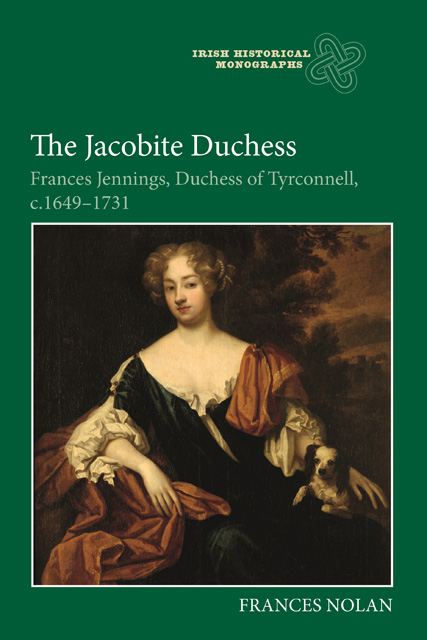Book contents
- Frontmatter
- Dedication
- Contents
- List of illustrations
- Acknowledgements
- List of abbreviations
- Notes on the text
- Introduction
- 1 ‘The malicious little gipsy’: Early life, c.1649–65
- 2 ‘Hambleton is now going into France’: Marriage, motherhood and migration, 1666–76
- 3 ‘Ruined beyond redemption’?: Widowhood, remarriage and returning, 1676–86
- 4 ‘That caballing humour’: A political woman, 1687–90
- 5 ‘Every one’s eye is watching’: Treason, forfeiture and exile, 1691–99
- 6 ‘Always a plane dealor’: Changing fortunes and life in the Low Countries, 1700–08
- 7 ‘A duchess-nun’?: Family, faith and finance in old age, 1708–30
- 8 ‘Albion’s fairest plant’: Death and legacy, 1731
- Appendix A: Duchess of Tyrconnell’s family tree
- Appendix B: Books in the possession of the duchess of Tyrconnell in Dublin, transported from her apartment in the Château de Saint-Germain-en-Laye
- Appendix C: David Nairne’s ‘Cyffer w[i]th the D[uche]sse of Tyrconnel, 5th August 1702’
- Bibliography
- Index
- Irish Historical Monographs previous volumes
4 - ‘That caballing humour’: A political woman, 1687–90
Published online by Cambridge University Press: 04 January 2024
- Frontmatter
- Dedication
- Contents
- List of illustrations
- Acknowledgements
- List of abbreviations
- Notes on the text
- Introduction
- 1 ‘The malicious little gipsy’: Early life, c.1649–65
- 2 ‘Hambleton is now going into France’: Marriage, motherhood and migration, 1666–76
- 3 ‘Ruined beyond redemption’?: Widowhood, remarriage and returning, 1676–86
- 4 ‘That caballing humour’: A political woman, 1687–90
- 5 ‘Every one’s eye is watching’: Treason, forfeiture and exile, 1691–99
- 6 ‘Always a plane dealor’: Changing fortunes and life in the Low Countries, 1700–08
- 7 ‘A duchess-nun’?: Family, faith and finance in old age, 1708–30
- 8 ‘Albion’s fairest plant’: Death and legacy, 1731
- Appendix A: Duchess of Tyrconnell’s family tree
- Appendix B: Books in the possession of the duchess of Tyrconnell in Dublin, transported from her apartment in the Château de Saint-Germain-en-Laye
- Appendix C: David Nairne’s ‘Cyffer w[i]th the D[uche]sse of Tyrconnel, 5th August 1702’
- Bibliography
- Index
- Irish Historical Monographs previous volumes
Summary
Leaving the court at Windsor at the beginning of 1687, Lady Tyrconnell travelled with her husband to Chester, where they lodged at the bishop’s palace for a night. Richard then returned to Dublin to take up his post as lord deputy, while Frances returned to London to attend the queen. While they lived apart, the couple remained active and ambitious in family affairs: in May 1687, Sunderland wrote to Lord Tyrconnell and informed him that the king had agreed that the earl of Clanricard’s son, Ulick Bourke, be elevated to the Irish peerage, in expectation of his marriage to Lady Frances Hamilton. Bourke was created Viscount Galway the following June, but the marriage negotiations broke down. Instead, Frances Hamilton married Henry Dillon, Lord Tyrconnell’s grandnephew and heir to the viscountcy of Costello-Gallen, in July 1687, bringing a generous portion of £3,000 to her husband. With another daughter successfully extracted from the marriage market, Lady Tyrconnell joined the queen on her summer progress to Bath, where Mary Beatrice took the waters to improve her poor health and increase her chances of conceiving a child.
By this time the queen had endured a number of miscarriages and stillbirths, had lost four children in early infancy and, in 1681, had suffered the death of her only surviving child, the four-year-old Princess Isabella. Catholic hopes and Protestant fears of a male heir to the Stuart throne had faded considerably in the intervening years. The queen, who suffered her last miscarriage in May 1686, was in poor health, and the royal couple proceeded more in hope than expectation. Having concluded his own summer progress at Holywell, James joined his wife in Bath, and the efficacy of the spa waters was put to the test. On his way there, the king met Lord Tyrconnell at Shrewsbury and they travelled together to Chester. The Irishman had been summoned to explain a shortfall in the Irish revenue and feared that his dismissal from the lord deputyship was imminent.
- Type
- Chapter
- Information
- The Jacobite DuchessFrances Jennings, Duchess of Tyrconnell, c.1649-1731, pp. 85 - 113Publisher: Boydell & BrewerPrint publication year: 2021

